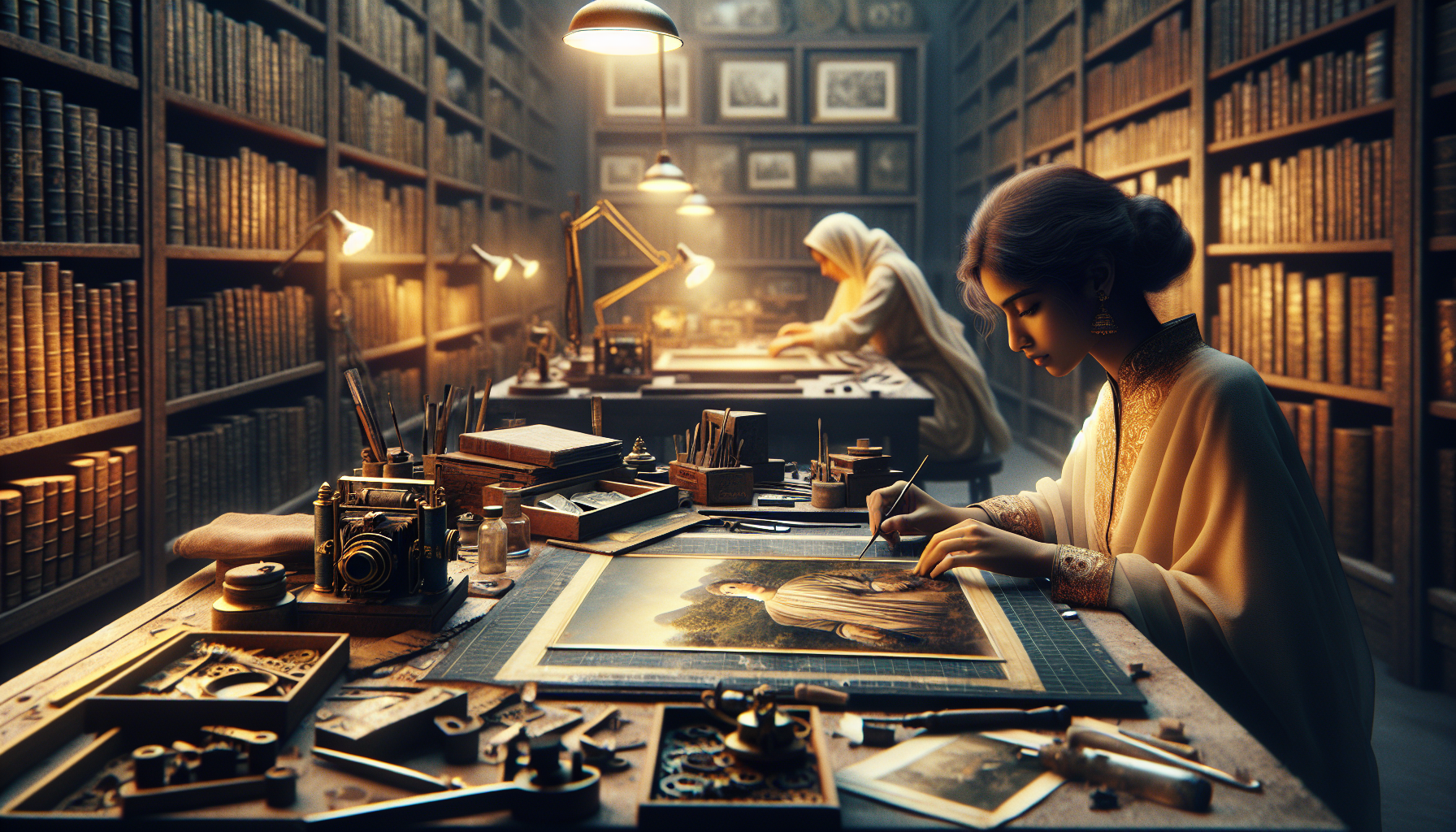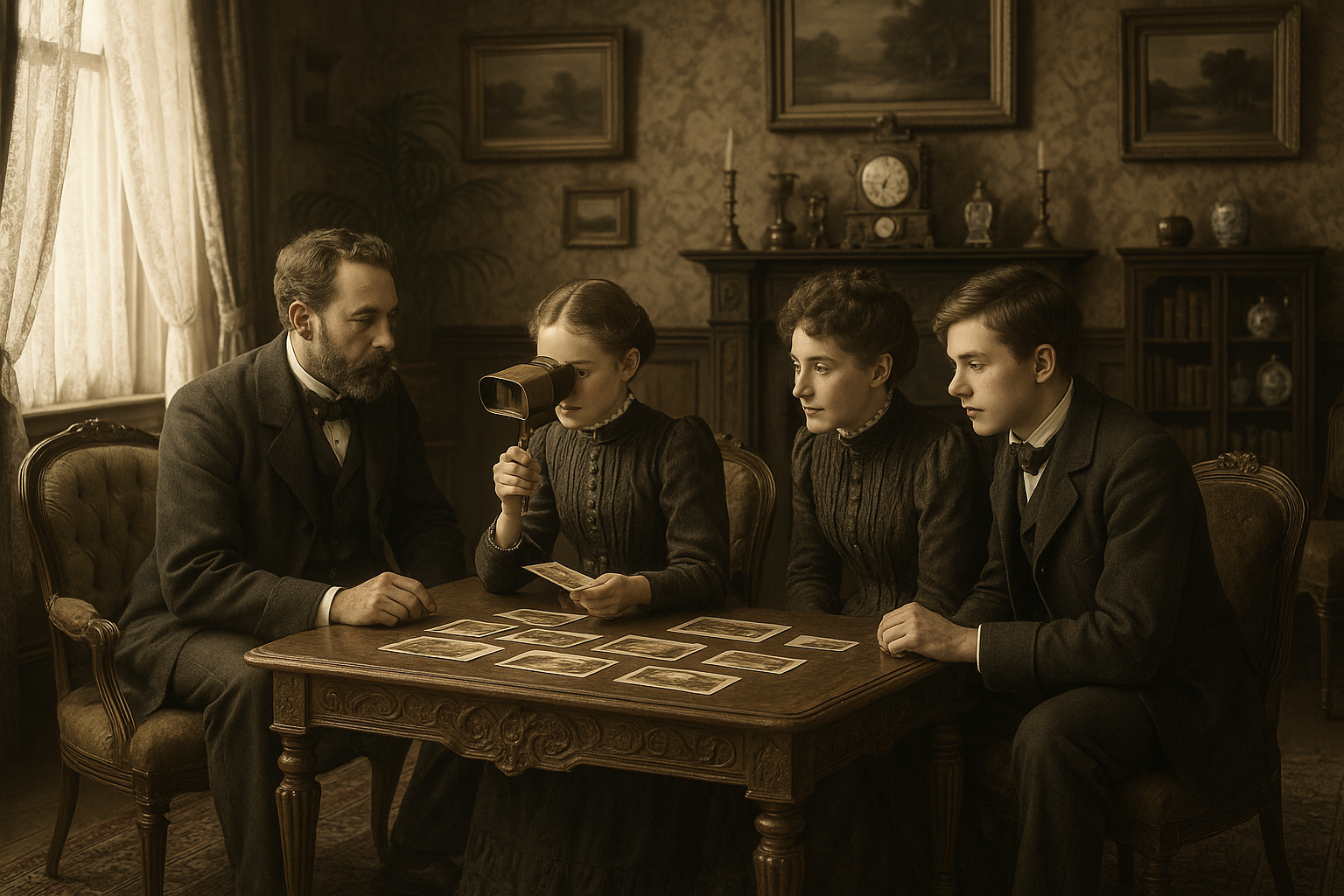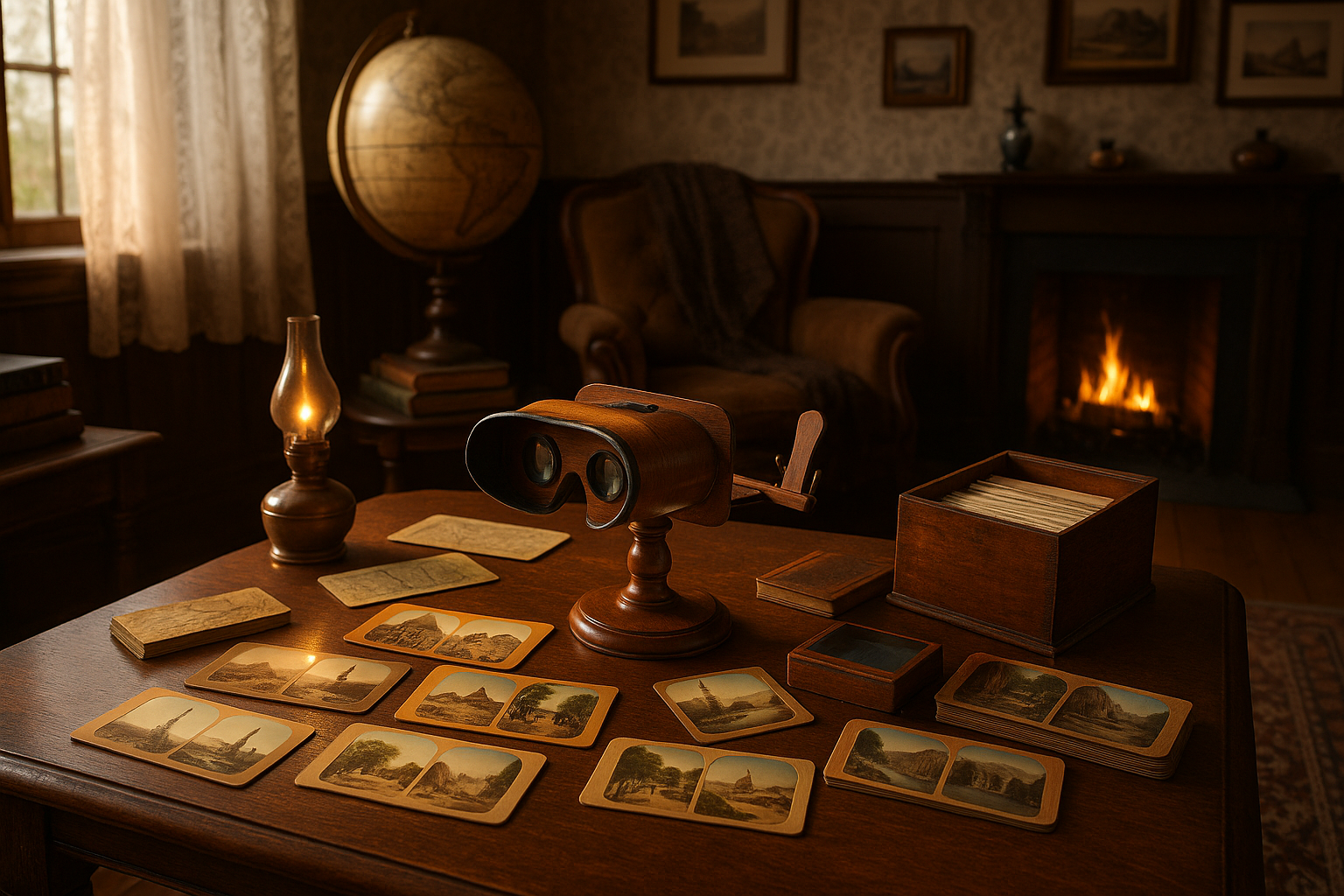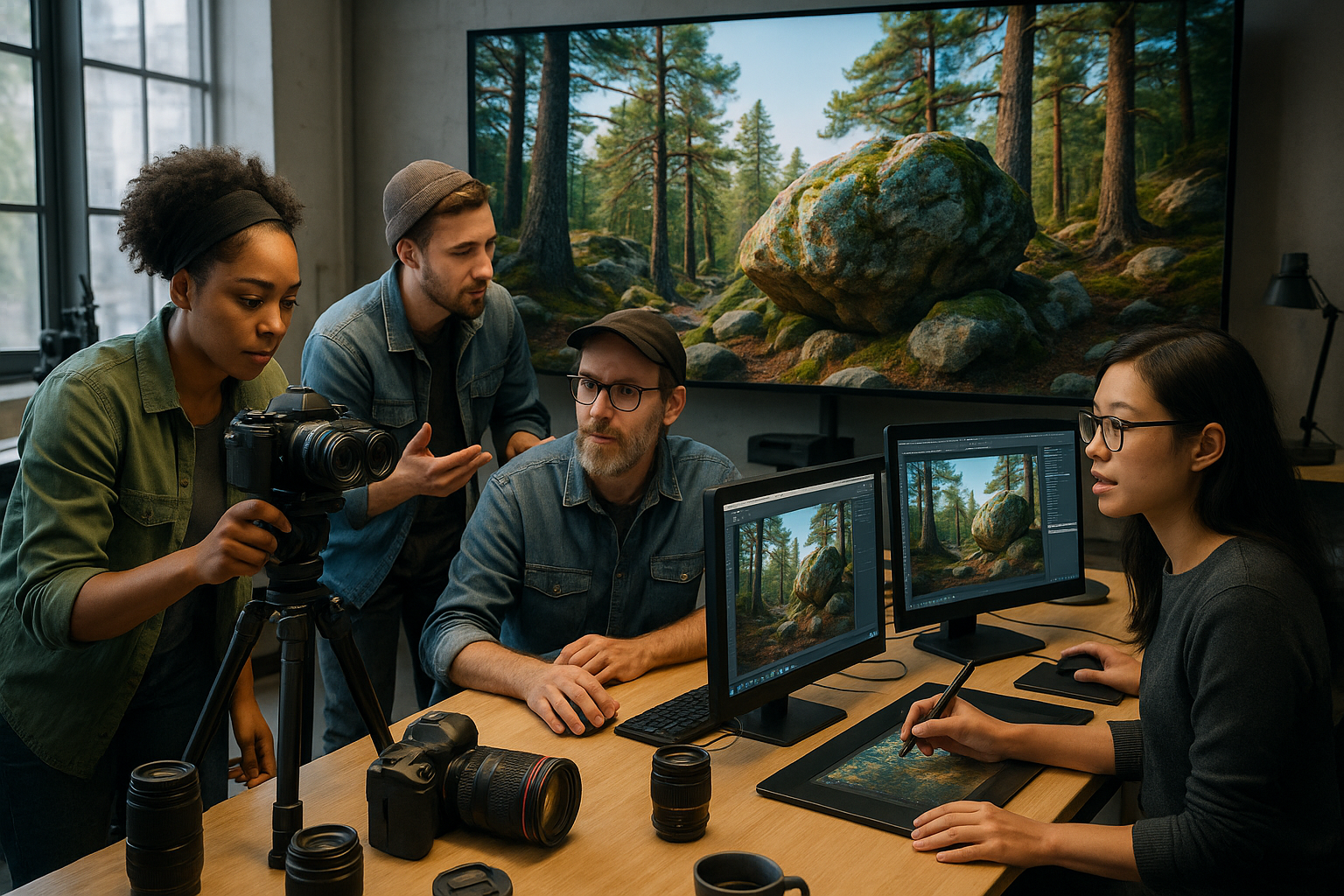In a world where technology evolves at lightning speed and digital images saturate our daily lives, it’s easy to forget the charm and historical significance of early photographic techniques. Imagine a time when photography was an art reserved for the few, a magical process that could capture moments and render them almost tangible through clever optical illusions. Among the treasures of this bygone era lies the stereograph—a dual-image wonder that, when viewed through a stereoscope, springs to life in three dimensions. 🌟 Once a centerpiece of Victorian parlors and a window to the wonders of the world for many, stereographs now sit quietly in the archives of collectors and historians, waiting to be unlocked once more. This blog delves into the fascinating art and science of stereograph preservation and restoration, a craft that safeguards these historical gems for future generations.
The allure of stereographs extends beyond their visual trickery; they serve as time capsules, offering glimpses into the landscapes, cultures, and daily lives of the 19th and early 20th centuries. Each card tells a story, not just of the subject it depicts but of the photographers and publishers who pioneered this art form. Stereographs were, in many ways, the virtual reality of their day, inviting viewers to step into another world without ever leaving their homes. Despite their past popularity, these images face a perilous future, threatened by the ravages of time, neglect, and technological obsolescence. 📚🕰️ Preserving and restoring these delicate artifacts is both a science and an art, requiring meticulous attention to detail and a deep understanding of historical context.
In our exploration, we’ll journey through the history of stereographs, understanding their origins and how they captured the imagination of an era. We’ll meet the pioneers whose innovation and vision gave birth to this phenomenon and the cultural impact that followed. From the grand vistas of foreign lands to intimate family portraits, stereographs covered a wide array of subjects, each carefully composed to maximize their three-dimensional effect. We’ll discuss the technical aspects of how these images were created and why they remain so captivating. 🖼️ Moreover, we’ll delve into the modern-day challenges faced in preserving these images, from chemical deterioration to physical damage, and the innovative techniques conservators employ to combat these issues.
Finally, we’ll uncover the process of restoration, where artistry meets science. Restorers must strike a delicate balance between repairing damage and maintaining authenticity, often employing both traditional methods and cutting-edge technology. We’ll examine case studies that highlight the triumphs and challenges of this meticulous work, showcasing how passion and precision come together to breathe new life into these snapshots of history. By the end of this article, you’ll have a newfound appreciation for the stereograph, not just as a relic of the past, but as a bridge connecting us to a world long gone, yet vividly alive through the lens of preservation and restoration. Join us on this captivating journey into the heart of history, and discover the art of unlocking the past. 🏛️
The Fascinating World of Stereographs
Stereographs, once a popular form of entertainment and education, are dual images that, when viewed through a stereoscope, create a three-dimensional effect. Originating in the mid-19th century, these images captivated the public, offering a glimpse into distant lands, historical events, and everyday life with a sense of depth and realism that was unparalleled at the time. They served not only as a source of amusement but also as a tool for learning, making distant cultures and events more tangible to the average person. As we delve into the art of stereograph preservation and restoration, it’s essential to understand their historical significance and the craftsmanship involved in their creation.
In the 19th century, the advent of stereography coincided with a burgeoning interest in photography. The ability to capture three-dimensional images was revolutionary, and it quickly became a popular medium for both professionals and amateurs. The stereoscope, a device used to view these images, was a common household item, much like a television today. Families would gather around, viewing scenes from around the world, experiencing the sensation of “being there.” As such, stereographs played a crucial role in shaping public perceptions and understanding of global events and cultures. They provided an accessible means for people to explore the world beyond their immediate surroundings, fostering a sense of global awareness and connectivity.
The creation of a stereograph was an intricate process. Photographers had to capture two nearly identical images from slightly different angles, mimicking the slight disparity between human eyes. These images were then mounted side by side on a card, which would be placed in a stereoscope for viewing. The resulting 3D effect was both mesmerizing and educational, allowing viewers to perceive depth and detail in a way that single photographs could not. As we explore the techniques for preserving and restoring these historical treasures, it’s important to appreciate the skill and artistry that went into their original creation.
Challenges in Preserving Stereographs
Preserving stereographs presents unique challenges due to the nature of their materials and the conditions under which they were stored. Most stereographs were produced on paper or card stock, which are susceptible to degradation over time. Factors such as exposure to light, humidity, and temperature fluctuations can cause fading, discoloration, and physical damage to these delicate items. Additionally, the adhesives used in mounting the images can deteriorate, leading to separation and further loss of integrity.
One of the primary concerns in preserving stereographs is the prevention of further deterioration. This requires creating an environment that minimizes exposure to harmful elements. Ideal conditions include low humidity levels, stable temperatures, and limited exposure to light, particularly ultraviolet light, which can accelerate fading and damage. Storage solutions such as acid-free boxes and sleeves are essential for protecting these artifacts, as they help to prevent physical damage and reduce the risk of chemical reactions that can cause deterioration.
Another significant challenge in stereograph preservation is addressing existing damage. Restoration efforts must be carefully considered, as improper techniques can cause further harm. Professional conservators often employ a range of techniques to stabilize and repair damaged stereographs. This may include cleaning, mending tears, and consolidating flaking or lifting emulsion layers. Each intervention must be meticulously planned and executed to preserve the historical integrity of the piece while extending its lifespan for future generations to appreciate.
Modern Techniques in Restoration
In recent years, advances in technology have revolutionized the field of stereograph restoration. Digital imaging techniques allow conservators to create high-resolution scans of stereographs, capturing intricate details without physically handling the fragile originals. These digital copies can then be used for various purposes, including virtual exhibits, research, and educational programs. Additionally, digital restoration tools enable conservators to correct visual imperfections such as fading, discoloration, and damage without altering the original artifact.
One of the most exciting developments in stereograph restoration is the use of 3D modeling software. By creating digital models of the stereographs, conservators can simulate the original viewing experience without the need for physical handling. This not only preserves the integrity of the original artifacts but also allows for a broader audience to engage with these historical pieces. Virtual reality applications further enhance this experience, offering immersive environments where viewers can explore stereographic images as if they were viewing them through a traditional stereoscope.
The integration of digital technology into stereograph restoration represents a significant advancement in preserving our cultural heritage. By combining traditional conservation methods with modern technology, we can ensure that these fascinating artifacts remain accessible and appreciated by future generations. The following video offers further insights into modern restoration techniques:
Watch this informative video on modern restoration techniques: Modern Restoration Techniques by Art Conservation Channel
Comparative Analysis: Traditional vs. Modern Restoration Methods
To fully appreciate the advances in stereograph restoration, it’s helpful to compare traditional methods with modern techniques. Traditional restoration methods focused primarily on physical repairs, such as cleaning, mending, and reinforcing damaged areas. These techniques required a high degree of skill and precision, as improper handling could lead to further damage. The following table outlines some key differences between traditional and modern restoration methods:
| Aspect | Traditional Methods | Modern Methods |
|---|---|---|
| Focus | Physical repair and stabilization | Digital preservation and enhancement |
| Tools | Manual cleaning tools, adhesives, and conservation materials | Digital imaging software, 3D modeling, and virtual reality |
| Risks | Potential for physical damage due to handling | Minimal risk to originals; digital copies are manipulated |
| Accessibility | Limited to physical exhibitions and handling | Widespread access through digital platforms |
As the table demonstrates, modern restoration methods offer significant advantages in terms of accessibility and risk reduction. By digitizing stereographs, conservators can create a permanent record that can be shared widely without compromising the original artifacts. This not only preserves the historical value of these items but also makes them more accessible to researchers, educators, and the general public.
While modern techniques provide numerous benefits, they are most effective when combined with traditional methods. Physical restoration remains essential for addressing structural issues and stabilizing damaged stereographs. Together, these approaches ensure that our stereographic heritage is preserved and appreciated for generations to come.
The Role of Stereographs in Modern Education
Stereographs continue to play a vital role in education, offering unique opportunities for experiential learning and historical inquiry. By providing a tangible connection to the past, stereographs help students develop a deeper understanding of historical events and cultural contexts. The 3D effect created by stereographs enhances engagement and retention, making them an effective tool for visual learners.
Incorporating stereographs into modern educational curricula allows students to explore history in an immersive and interactive way. Teachers can use digital reproductions of stereographs to create virtual field trips, transporting students to historical sites and events. This approach not only enriches the learning experience but also fosters critical thinking skills as students analyze and interpret visual information.
The use of stereographs in education also encourages interdisciplinary learning. By examining stereographs, students can explore topics such as photography, art, history, and cultural studies. This holistic approach helps students make connections between different fields of study, promoting a more comprehensive understanding of the past and its relevance to the present. The following video illustrates how stereographs are being used in classrooms today:
Check out this video on using stereographs in education: Stereographs in Education by History Education Channel
Enhancing Public Engagement with Stereographs
Stereographs have the potential to captivate and educate a wide audience, making them an ideal medium for public engagement. Museums and cultural institutions can leverage the appeal of stereographs to attract visitors and enhance their exhibits. By offering interactive displays and virtual reality experiences, these institutions can create dynamic and engaging presentations that appeal to diverse audiences.
Public engagement with stereographs can also be facilitated through online platforms and social media. By sharing digital reproductions and interactive content, institutions can reach a global audience, fostering a greater appreciation for these historical artifacts. Online forums and communities provide opportunities for enthusiasts and scholars to connect, share insights, and collaborate on research and preservation efforts.
Ultimately, the art of stereograph preservation and restoration not only safeguards our cultural heritage but also enhances our understanding of the past. By embracing both traditional and modern techniques, we can ensure that these fascinating artifacts remain accessible and relevant to future generations. Whether through educational initiatives or public engagement, stereographs continue to inspire curiosity and wonder, bridging the gap between history and the present. 📸

Conclusion
In conclusion, the art of stereograph preservation and restoration is not merely a technical endeavor but a deeply enriching journey into the past that serves to illuminate the present and inspire the future. Throughout this article, we have delved into the multifaceted world of stereographs, exploring their historical significance, the meticulous techniques involved in their preservation, and the innovative approaches being developed to restore these precious artifacts.
One of the main points highlighted is the historical context of stereographs, which emerged in the 19th century as a revolutionary form of photography that allowed viewers to experience images in three dimensions. These visual time capsules captured moments of cultural, social, and scientific importance, offering invaluable insights into the lives and landscapes of the past. By preserving these images, we maintain a connection to our heritage, ensuring that future generations can appreciate and learn from the experiences and achievements of those who came before us.
The article also addressed the technical challenges and intricate processes involved in preserving stereographs. From dealing with the physical degradation of photographs to employing digital technologies for restoration, these efforts require a blend of traditional craftsmanship and modern innovation. The expertise of conservators and the application of advanced techniques, such as 3D scanning and digital archiving, play crucial roles in safeguarding these artifacts against the ravages of time.
Moreover, the importance of collaboration and community engagement in stereograph preservation cannot be overstated. Museums, libraries, and individual enthusiasts around the world are joining forces to share resources, knowledge, and expertise. This global network not only aids in the preservation efforts but also fosters a sense of shared responsibility and appreciation for our collective history. The digitization of stereographs, facilitated by platforms and online archives, further democratizes access to these images, allowing people from all walks of life to explore and enjoy them.
In reinforcing the significance of stereograph preservation, it is essential to recognize the broader impact on society and culture. These images offer a unique perspective on history, enriching our understanding and prompting us to reflect on how past experiences shape contemporary life. The preservation of stereographs, therefore, is not just about maintaining physical artifacts but also about preserving the narratives and stories they represent.
As we move forward, it is crucial to continue supporting the preservation and restoration of stereographs. By doing so, we ensure that these historical treasures remain accessible, engaging, and relevant. We encourage readers to get involved in these efforts, whether by visiting local museums, participating in preservation workshops, or contributing to online archives. Every action, no matter how small, helps to safeguard our visual heritage for future generations.
In the spirit of fostering a deeper appreciation for stereographs and their preservation, we invite you to share your thoughts and experiences. Have you encountered stereographs in your own explorations of history? Do you have insights or ideas about preservation techniques? Join the conversation by leaving a comment below or sharing this article with others who might be interested. Together, we can celebrate and preserve the art of stereography, ensuring its enduring legacy. 📚✨
For further exploration on the topic, you can visit resources such as the Library of Congress Stereograph Collection, and the Stereoscopic Society, where you’ll find a wealth of information and images that continue to captivate and educate.
By engaging with these resources and participating in the preservation community, we can all play a part in unlocking the past and keeping the art of stereography alive for generations to come. Thank you for joining us on this journey into the fascinating world of stereograph preservation and restoration.
Toni Santos is a visual historian and artisan whose creative lens is captivated by the forgotten marvels of antique optical devices. Through his thoughtful storytelling, Toni revives the instruments that once transformed light into wonder—camera obscuras, magic lanterns, kaleidoscopes, and other ingenious tools that shaped our earliest visual imaginations.
His journey is rooted in a fascination with how humans have long sought to bend, reflect, and reveal the unseen. Whether tracing the mechanical poetry of 19th-century projectors or illustrating the tactile elegance of early lenses, Toni’s work invites us to see vision itself as an evolving art form.
Blending handcrafted design with historical inquiry, Toni brings to life the material soul of these devices—celebrating not just how they functioned, but what they meant. His creations and curated stories illuminate a world where science, illusion, and beauty were intricately linked through glass and brass.
As the curator of Vizovex, Toni shares detailed studies, reconstructed artifacts, and immersive content that help others rediscover the origins of visual technology and the magic of analog perception.
His work is a tribute to:
The craftsmanship behind early visual instruments
The wonder of seeing through the eyes of another century
The intersection of optics, art, and imagination
Whether you’re a collector, a designer, or someone drawn to the lost poetry of vision, Toni welcomes you into a world where light is a storyteller—one prism, one lens, one forgotten invention at a time.





